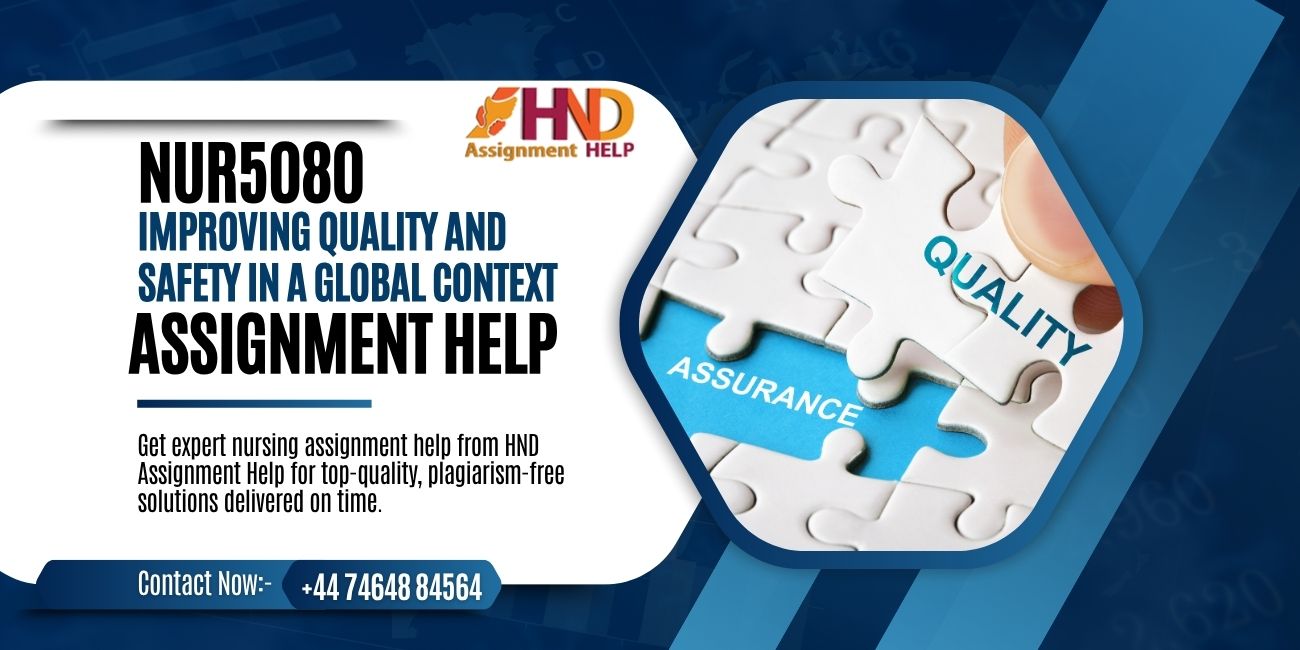Assignment help

Join our 150К of happy users
Get original papers written according to your instructions and save time for what matters most.


NUR5080 Improving Quality and Safety in a Global Context Assignment Help
NUR5080 Improving Quality and Safety in a Global Context Assignment
Assessment Information
Credits: 20
Semester:2
2024
Module Leader:Emily Dekker and Jo Day
Email: NUR5080@bcu.ac.uk
Overview
| Assessment(s) | Category | Type | Scope |
| 1 | Coursework | Essay | 2000 words |
Assessment 1
Individual written essay
100%
Submission Date: Monday, 02 September 2024
In all areas of nursing, patients with different cultures, backgrounds, health issues and standards of living, will access health services. For some, accessing healthcare and managing their health is easier than for others. Having an awareness of these issues and the impact this has on populations and at an individual level, can inform and change our nursing practice. Additionally, knowing how, as nurses, we can help our patients to improve quality of care and engage our patients in their own health, can greatly improve health outcomes, patient satisfaction, and reduce healthcare costs.
Assessment Title:‘An exploration of how health inequality can affect patients in our care; and how the use of health policy and self-management tools can enhance care nurses provide’
Assessment Task
From the list below, pick one health inequality to use for your discussion in your essay:
- Education
- Income
- Work (unemployment and quality of work)
- Housing (including homelessness)
- Environment (healthy spaces and food, air pollution etc)
- Access to healthcare (e.g. maybe more limited due to ethnicity, LGBT, disability, mental health)
If you have a health inequality you would like to use for you essay that is not in this list, please speak with the module lead to agree this first.
What to include:
- Compose a 2000 word written essay.
- Consider a patient you have looked after and briefly introduce the patient in your introduction, identifying one of their health issues.
- Select one health inequality (from the choice offered)which has affected the patient or service user you have looked after.
- Critically discuss the impact of this health inequality on the patient.
- Recommend and apply one health policy that can support healthcare to reduce either the inequality or health condition, ensuring you address how the nurse can use this policy to improve safety and quality of care.
- Identify a behaviour change that your patient could adopt to improve their own wellbeing and recommend and apply one self-management initiative to your chosen patient/service-user that could support this behaviour change.
- Explain one underpinning ethical nursing principle of your chosen self-management initiative
- Link your discussion with one or more of the United Nations Sustainable goals.
Maintain confidentiality, referring to the NMC code, and where required, create a pseudonym for your patient.
Submission Details
Your work needs to be submitted on a Word document into your Moodle submission point.
Formatting
- Please type in size 12, either ‘Times New Roman’ or ‘Arial’ font.
- Double space your work.
- You must include an introduction and conclusion, and you may use the subheadings if you find this easier to present and guide your work. Subheadings are not essential.
- Appendices are NOT to be used.
- Use the full 2000word count. There is a 10% allowance above the word count (2200 words maximum). Work after 2200 words will not be marked. Intext citations are included in the word count. The reference list is not included in the word count.
- Any breach of confidentiality will be recorded as a technical fail with a 0% grade.
- Submit your cover sheet separately to your assignment.
- Follow BCU referencing guidelines for all intext citations and reference list: Referencing - Library & Learning Resources | Birmingham City University (bcu.ac.uk)
Assessment Support
There will be opportunities throughout the module taught content for support with your assignment. For additional support, please see the previous section on ‘Where to get help’
Here are some suggested links to get you started: Gov.UK (2022) Search-Policy. Available at:policy - Search - GOV.UK (www.gov.uk)[Accessed 25 November 2022]
NHS England (2022) Commissioning Policies. Available at: NHS commissioning » Commissioning policies (england.nhs.uk)[Accessed 24 November 2022]
NHS England (2022) Supported self-management. Available at:NHS England » Supported self-management[Accessed 20 November 2022]
United Nations (2022) The 17 Goals. Available at: THE 17 GOALS | Sustainable Development (un.org)[Accessed 11 November 2022]
Note: We expect you to be using other sources beyond these. This is just a starting reference point for you. |
| Criterion | 0-20% Fail | 20-39% Fail | 40-49%
| 50-59%
| 60-69%
| 70-79%
| 80-100%
|
|---|---|---|---|---|---|---|---|
Structure and Organisation
| Poor structure and organisation of the assignment, which:
| Poor structure and organisation of the assignment, which:
| Satisfactory structure and organisation of the assignment, which:
| Good structure and organisation of the assignment, which:
| Very good structure and organisation of the assignment, which:
| Excellent structure and organisation of the assignment, which:
| Outstanding structure and organisation of the assignment, which:
|
| Communication of Ideas | Poor communication of ideas, which:
| Poor communication of ideas, which:
| Satisfactory communication of ideas, which:
| Good communication of ideas, which:
| Very good communication of ideas, which:
| Excellent communication of ideas, which:
| Outstanding communication of ideas, which:
|
| Application ofknowledge and Critical Thinking Principles | Poor application of knowledge, and critical
| Poor application of knowledge, and critical thinking, which:
| Satisfactory application of knowledge, and critical thinking, which:
| Good application of knowledge, and critical thinking, which:
| Very good application of knowledge, and critical thinking, which:
| Excellent application of knowledge, and critical thinking, which:
| Outstanding application of knowledge, and critical thinking, which:
|
| Use of Sources to Support Work | Poor use of sources to support work, which:
| Poor use of sources to support work, which:
| Satisfactory use of sources to support work, which:
| Good use of sources to support work, which:
| Very good use of sources to support work, which:
| Excellent use of sources to support work, which:
| Outstanding use of sources to support work, which:
|
This assessment addresses the following learning outcomes (LOs):
| |||||||
Key Information
Conditions of Progression
| You are required to achieve 40% to pass this assignment
2 attempts |
| Late or Non-Submission/ Attendance | Assessments must be submitted in the format specified in the assessment task, by the deadline and to the submission point published on Moodle.Failure to submit by the published deadline will result in penalties which are set out in Section 6 of the Academic Regulations, availableat:
Please be aware that the penalties are different for re-submissions and ‘in-year retrievals’.
For in-person assessments, you should arrive 15 minutes before your allocated time slot. Failure to present at your allocated time, will result in you being unable to sit the assessment and you will be recorded as a non-submission, resulting in a grade of 0. |
| Word Count | The word count for this module assessment is shown under the assessment task. A +10% margin of tolerance is applied, beyond which nothing further will be marked. Marks cannot be awarded for any learning outcomes addressed outside the word count.
The word count refers to everything in the main body of the text (including headings, tables, citations, quotes, lists etc.). Everything before (i.e. abstract, acknowledgements, contents, executive summaries etc.) and after the main text (i.e. references, appendices) is not included in the word count limit.
For in-person assessments time limits will be applied. |
| Academic Integrity Guidance | Academic integrity is the attitude of approaching your academic work honestly, by completing your own original work, attributing, and acknowledging your sources when necessary. Understanding good academic practice in written and oral work is a key element of academic integrity. It is a positive aspect of joining an academic community, showing familiarity with, and acknowledging sources of evidence. The skills you require at higher education may differ from those learned elsewhere such as school or college.
You will be required to follow specific academic conventions which include acknowledging the work of others through appropriate referencing and citation as explicitly as possible. If you include ideas or quotations which have not been appropriately acknowledged, this may be seen as plagiarism which is a form of academic misconduct. If you require support around referencing, please contact theFaculty’s Academic Development Department or the University wideCentre for Academic Success.
It is important to recognise that seeking out learning around academic integrity will help reduce the risk of misconduct in your work. Skills such as paraphrasing, referencing and citation are integral to acting with integrity and you can develop and advance these key academic skills through the Faculty’s Academic Development Department. |
Academic Misconduct
| Academic misconduct is conduct which has or may have the effect of providing you with an unfair advantage by relying on dishonest means to gain advantage and which therefore compromises your academic integrity.
The procedure sets out the process we will follow, and the penalties we may apply, in cases where we believe you may have compromised your academic integrity by committing academic misconduct. The Academic Misconduct Procedure and information about academic support is available at: https://icity.bcu.ac.uk/Student-Affairs/Appeals-and-Resolutions/Academic-Misconduct-Procedure |
| Turnitin | To obtain a Turnitin scan before submitting your work to your department please visit the University's ‘Turnitin at BCU’ Moodle site. Work that is submitted and scanned through this service is not stored on the main Turnitin system and this is NOT your submitted work. |
| Extenuating Circumstances | For further details on the Extenuating Circumstances Procedure please see the iCity page below: https://icity.bcu.ac.uk/student-affairs/appeals-and-resolutions/extenuating-circumstances-procedure |
| Where to get help | The University has a designated student support service known as the Centre for Academic Success.Here you will find support for a range of academic skills. Likewise, you can arrange a consultation with a member of staff from the Academic Development Departmentbased at City South Campus. You also should also review the wide range of support and help from the library. |
| Resit Period | Our aim is for all students to pass the module at first attempt. However, there are occasions where students fail a module are required to resit their assessment. The formal resit week is Monday 22 July – Friday 02 August 2024. It is important that you are available during this time period, should you be required to resit an assessment. |
Send Your assignment brief
Share your assignment brief and after Checking assignment requirement expert Will share the quote
Get Quote and pay
Once quote is sent, you can make Payment through secure option after which our team will start work
Get Assignment
Our team will Deliver the work you can share If any feedback

